
Special Issue: Bullying and Cyberbullying
Effects of a Brief Preventive Intervention in Cyberbullying and Grooming in Adolescents
[Los efectos de una intervenci├│n preventiva breve en ciberacoso y grooming en adolescentes]
Esther Calvete1, Nerea Cortazar1, Liria Fernández-González1, Ainara Echezarraga1, Marta Beranuy2, Ana León3, Joaquín González-Cabrera3, and Izaskun Orue1
1University of Deusto, Spain; 2Universidad de Navarra, Spain; 3Universidad Internacional de la Rioja, Spain
https://doi.org/10.5093/pi2020a22
Received 15 June 2020, Accepted 16 September 2020
Abstract
The development of brief and inexpensive interventions that reduce risky behaviors in adolescence constitute a challenge for current research. This study addresses the prevention of two online behavior problems in adolescents (cyberbullying and online grooming). Two pilot studies evaluated the effects of a 1-hour intervention, which combined self-affirmation (SA) with the incremental theory of personality (ITP), for cyberbullying and online grooming. Study 1 involved 339 adolescents (51% male, mean age = 14.12 years, SD = 0.70), who were randomly assigned to the SA + ITP intervention or one of two control conditions. Hierarchical regression analyses indicated that the SA + ITP intervention reduced the reciprocity between sexual solicitation and sexualized interaction with adults, as well as between cyberbullying victimization and perpetration. Study 2 included 214 adolescents (50.3% male, mean age = 14.06 years, SD = 0.96), who were randomly assigned to the SA + ITP or a control condition. Hierarchical linear modeling analyses indicated that the SA + ITP reduced the reciprocity between sexual solicitation and sexualized interaction with adults, and reduced cyberbullying perpetration. The studies provided preliminary evidence of the benefits of the SA + ITP intervention.
Resumen
El desarrollo de intervenciones breves y económicas que reduzcan las conductas de riesgo en la adolescencia constituye un desafío para la investigación actual. Este estudio aborda la prevención de dos problemas de comportamiento online en adolescentes (ciberacoso y grooming en Internet). Dos estudios piloto evaluaron los efectos de una intervención de una hora que combinó autoafirmaciones (AA) con la teoría incremental de la personalidad (TIP) en el ciberacoso y el grooming. En el estudio 1 participaron 339 adolescentes (51% chicos, edad media = 14.12 años, DT = 0.70), que fueron asignados aleatoriamente a la intervención AA + TIP o una de dos condiciones de control. Los análisis de regresión jerárquica indicaron que la intervención AA + TIP redujo la reciprocidad entre la solicitud sexual y la interacción sexualizada con adultos, así como entre la victimización y la perpetración de ciberacoso. El estudio 2 incluyó a 214 adolescentes (50.3% chicos, edad media = 14.06 años, DT = 0.96), que fueron asignados aleatoriamente a AA + TIP o a una condición de control. Los análisis de modelos lineales jerárquicos indicaron que AA + TIP redujo la reciprocidad entre la solicitud sexual y la interacción sexualizada con adultos y redujo la perpetración de ciberacoso. Los estudios aportaron evidencia preliminar de las ventajas de la intervención AA + TIP.
Keywords
Incremental theory of personality, Self-affirmation, Cyberbullying, Grooming, Adolescents, Wise interventionPalabras clave
Teor├şa incremental de la personalidad, Autoafirmaci├│n, Acoso cibern├ętico, Grooming, Adolescentes, Intervenci├│n inteligenteCite this article as: Calvete, E., Cortazar, N., Fernández-González, L., Echezarraga, A., Beranuy, M., León, A., González-Cabrera, J., and Orue, I. (2021). Effects of a Brief Preventive Intervention in Cyberbullying and Grooming in Adolescents. Psychosocial Intervention, 30(2), 75 - 84. https://doi.org/10.5093/pi2020a22
esther.calvete@deusto.es Correspondence: esther.calvete@deusto.es (E. Calvete).Although the Internet offers great opportunities for adolescents, at the same time it involves potential risks. Two such risks are cyberbullying and grooming. Cyberbullying includes sending or posting derogatory images, videos, and messages, which can remain on the Internet, to harm a person or group. Moreover, third parties can share these media, which implies a form of re-victimization (Stonard et al., 2014). Similar to traditional bullying, cyberbullying negatively affects the health and quality of life of victims (Fisher et al., 2016). Furthermore, the fact that online assaults are mainly indirect rather than face-to-face (Smith, 2012) implies that the aggressor does not see a victim’s reaction immediately, which can facilitate insensitivity and lack of empathy toward the victim. Another problem for adolescents on the Internet is online grooming, which can lead to severe consequences for victims. Online grooming involves a process by which an adult, using digital media, targets a minor to obtain sexual material (images and videos) or to sexually abuse the adolescent. Studies on adolescents aged 10 to 17 years indicated a prevalence of the problem between 5% and 9% (Bergen et al., 2014). In Spain, a study on adolescents between 12 and 15 years old found that 12% of the respondents had been victims of sexual solicitations by adults in the previous year (de Santisteban & Gámez-Guadix, 2017, 2018) sexual requests by an adult. A common characteristic of cyberbullying and grooming is the high reciprocity between victimization and behavior execution. Thus, the association between cyberbullying victimization and perpetration is typically high (Royuela-Colomer et al., 2018). In the case of cyberbullying, Erreygers et al. (2018) proposed that this reciprocity could be explained by the General Aggression Model (Anderson & Bushman, 2002). Victims of aggression can perceive the aggression as intentional, harmful, or unjustified, and experience a desire of revenge and turn against the bully, creating a violent escalation cycle (Anderson et al., 2008). In addition to possible vengefull reactions, other mechanisms have been suggested to explain why victimization may increase the likelihood of perpetration. Holfeld and Mishna (2018) proposed that youth who have first-hand experience with cybervictimization become more aware of and sensitive to experiences of cyberbullying against other people, and their witnessing cyberbullying could contribute to normalizing these behaviors and, through social learning processes, to imitating these behaviors in future. Reciprocity also takes place in the case of grooming, as a high association is frequently observed between sexual solicitation (i.e., an adult contacts an adolescent and asks him/her to send materials, such as photos or videos of a sexual nature) and the behaviors of establishing risk interactions with the requesting adult (Gámez-Guadix, Almendros, et al., 2018). The emergence of these problems on the Internet has motivated the development of various preventive interventions that aim to reduce risky behavior on the Internet. Compared with antibullying programs, few studies have evaluated the effectiveness of cyberbullying interventions (Ng et al., 2020). Some programs that have found promising results in reducing cyberbullying among adolescents are the ViSC social competence program (Gradinger et al., 2016), the prev@Cib (Ortega-Barón et al., 2019), the Tabby Improved Program (Sorrentino et al., 2018), the Cyber Friendly School Program (Cross et al., 2016), the Cyberprogram 2.0 (Garaigordobil & Martínez-Valderrey, 2015), and the Asegúrate [Make sure] Program (del Rey et al., 2018). Most of these programs target both traditional and online bullying and some were designed to prevent traditional bullying but have also shown positive results in reducing cyberbullying (e.g., KiVa program; Williford et al., 2013). Although the worldwide efficacy results of different programs are encouraging, in a recent meta-analytical review, Gaffney et al. (2019) concluded that evidence of the efficiency of such interventions remains scarce. Moreover, although there is an increasing number of studies that target other Internet risks, such as online grooming (Gámez-Guadix, Almendros et al., 2018; Machimbarrena et al., 2018), there are very few school-based programs designed specifically to reduce such behaviors. One such program designed to reduce grooming behaviors consists of a one-hour session of psychoeducation and teaching strategies to face those situations (Gámez-Guadix, 2018). This program is based on videos and in-class discussions. Besides, as concluded by Forni et al. (2020) in a recent review, although some preventive strategies for online grooming have been proposed in the previous decade, the need is clear for studies that investigate the efficiency of such interventions. Notably, adolescence constitutes a challenge for the development of preventive interventions. According to the results of meta-analytic studies, the effectiveness of interventions in adolescence is extremely limited. For example, Evans et al. (2014) conducted a review of studies that examined the effects of bullying interventions and found that only 50% provided evidence of significant effects on bullying reduction. In a hierarchical meta-analysis, Yeager et al. (2015) proposed that traditional antibullying interventions were effective from childhood to early adolescence. However, a decrease in the effectiveness was noted with the increase in age until reaching a null effect in the case of adolescents. Many universal preventive interventions are based on theories of decision-making and generation of change through reflective knowledge. Such interventions assume the premise that if adolescents receive information about risks, skills training, and education in appropriate values, then behavior change will be facilitated. However, some characteristics of adolescence can create resistance to these approaches. Compared with children, adolescents are more sensitive to the need for being respected and the recognition of their autonomy (Yeager et al., 2018). Therefore, if adolescents perceive that adults are trying to manipulate them or introduce changes in their behavior in such a manner that threatens autonomy, then they will typically resist. They then use avoidance strategies, such as ignoring or criticizing the messages (Sweeney & Moyer, 2015). Recently, interest in a new approach to interventions, which have been called “wise interventions,” has increased. This method involves a rigorous set of techniques based on theory and research, which address specific psychological processes to enable people to thrive in diverse life settings (for a review, see Walton & Wilson, 2018). Wise interventions emphasize subjective meaning creation, personal interpretations, and social situations. In doing so, these interventions can effectively change behavior recursively over time (Walton, 2014). In recent years, a proliferation of wise interventions has addressed several social and personal problems. Many of these interventions have shown impressive results because they are frequently short-term (often single sessions of one hour) and produce lasting changes in behavior. Thus, many wise interventions have been shown to improve academic performance (Brisson et al., 2017), social integration of ethnic minority youth (Brannon & Walton, 2013), and reduce depression (Miu & Yeager, 2015) and aggressive behavior (Calvete, Fernández-Gonzalez, et al., 2019; Fernández-González et al., 2020) . Wise interventions do not address risky behaviors directly. Rather, they focus on cultivating three basic motives that drive individuals’ search for meaning, namely, (1) precision (people want their interpretations to be accurate), (2) self-integrity (people want to think well of themselves and believe that they are appropriate and competent), and (3) belonging (people want to feel accepted and included by others and to contribute positively to the lives of others). Also, wise interventions are based on the principles of the psychology of persuasion. In general, they do not tell people that they “should” adopt a new belief or behavior, but rather allow them to adopt it independently (Brady et al., 2016; Silverman et al., 2013). Therefore, this type of intervention is of great interest during adolescence, as such interventions are designed to be perceived as respectful of adolescents’ autonomy and status, which enhances making personal decisions (Yeager et al., 2018). The results obtained with this type of intervention in adolescent behaviors are auspicious. From the perspective of wise interventions, Miu and Yeager (2015) and Yeager et al. (2013) designed a brief universal intervention to change implicit beliefs about adolescent personality. Specifically, the intervention focused on teaching the ITP, which consists of the belief that people’s personality and behavior can change. The intervention was characterized by students’ active role, which facilitated deep processing of the message and was presented without aiming to change behavior. In this manner, the students did not feel manipulated, and this reduced their resistance to the intervention. Several studies found that the ITP intervention reduces internalizing symptoms, such as anxiety and depression (e.g., Calvete, Fernández-Gonzalez, et al., 2019; Miu & Yeager, 2015; Schleider & Weisz, 2018). Furthermore, many studies found that it can reduce aggressive behaviors (Yeager et al. 2013), such as cyberbullying (Calvete, Fernández-Gonzalez, et al., 2019) and cyberdating abuse (Fernández-Gonzalez et al., 2020) given the limited results of existing programs in achieving behavioral changes. The main objective of this study was to explore the effect of a brief, single-session intervention aimed at promoting an incremental theory of personality (ITP. Specifically, Calvete, Orue, et al. (2019) reported that a single-session of ITP intervention reduced the reciprocity between victimization and perpetration of cyberbullying among the youngest adolescents of their sample. In other words, adolescents who received the ITP intervention were less likely to react with aggressive cyberbullying behaviors if they become victims of cyberbullying. Other types of wise interventions that have been used in many areas are the so-called self-affirmation (SA) interventions, which are based on the postulate that people are motivated to maintain self-integrity (Cohen & Sherman, 2014; Steele, 1988). When individuals perform actions that demonstrate adequacy, they feel sufficiently competent and less motivated to resist threatening messages, such as persuasive attempts to change their behavior. SA interventions use SA procedures intending to activate a sense of self-integrity and adequacy. One SA intervention that has been used in several studies involves presenting a list of values (e.g., social, artistic, and political) and instructing the participants to select the values they deem most important and explain the importance of such values (Good & Abraham, 2011). Typically, studies compare SA with a control intervention, where participants are asked to select values they deem irrelevant and describe why such values may be important to others (other-affirmation; OA). SA procedure can be used in combination with other types of interventions, such as persuasive messages, to improve behavior. In a meta-analysis, Epton et al. (2014) found that deploying SA inductions together with persuasive health information promoted message acceptance, intention to change, and subsequent positive behavior. SA interventions have been used to improve prosocial behavior and reduce antisocial behaviors in adolescents. Thomaes et al. (2009) argued that one type of SA intervention reduced narcissistic aggression for one school week in a sample of sixth and seventh graders. Armitage and Rowe (2017) also found that another form of SA intervention reduced relational aggression for over one month in a sample of children between 11 and 16 years. Overview of the Present Research The present studies aim to extend the previous results and test the effectiveness of a wise intervention in the prevention of two highly problematic online behaviors in adolescents, namely, perpetration of cyberbullying and grooming, through two pilot studies. Given the positive prior results for SA and ITP interventions, the current studies examine the effects of combining both intervention strategies. Thus, Study 1 compared an intervention combining SA and ITP (SA + ITP) with an intervention combining OA, which is considered the alternative control for SA, and ITP (OA + ITP), and with a control condition. Study 2 tested the intervention that was found most effective in Study 1 in another sample. We hypothesized that the SA + ITP intervention would be more effective in reducing cyberbullying and sexualized interaction with adults than the OA + ITP intervention. Furthermore, the OA + ITP intervention would be more effective than the control condition. The same effect was expected for the reciprocity between victimization and perpetration of behaviors (i.e., between cyberbullying victimization and perpetration and between sexual solicitation and sexualized interaction with adults). Participation was voluntary and participants were informed that their responses were confidential and would only be read by the research team. The procedure always followed the standards of the Declaration of Helsinki. The Ethics Committee of University of Deusto approved this study (Ref. ETK-9/19-20). Parent informed consent was required to participate in the study. Method Participants and procedure. We invited a random sample of 16 high schools in Alava (Basque Country, Spain) to participate. Of them, the headmasters of three private schools agreed to participate in Study 1. Although participants had received some educational talk related to Internet risks, the schools reported that they had not received any previous intervention program related to the subject matter of the study. Figure 1 displays the participation process through the different waves of the study. The final sample comprised 339 adolescents (51% were male, mean age = 14.12 years, SD = 0.70) who completed the interventions and measurements at the pretest and posttest. Adolescents were studying Grades 7 and 8 (51.7% and 48.3%, respectively). Random assignment was conducted at the individual level within each classroom and blocked by sex. Out of the 339, a total of 114 participants were allocated to the SA + ITP condition, 116 to the OA + ITP condition, and the remainder 109 to the control condition. To ensure blinding of condition assignment, notebooks with task interventions were distributed in an envelope (different colors were assigned for girls and boys) and the participants individually completed the task interventions on paper. Figure 1 Consort Diagram for Studies 1 and 2.  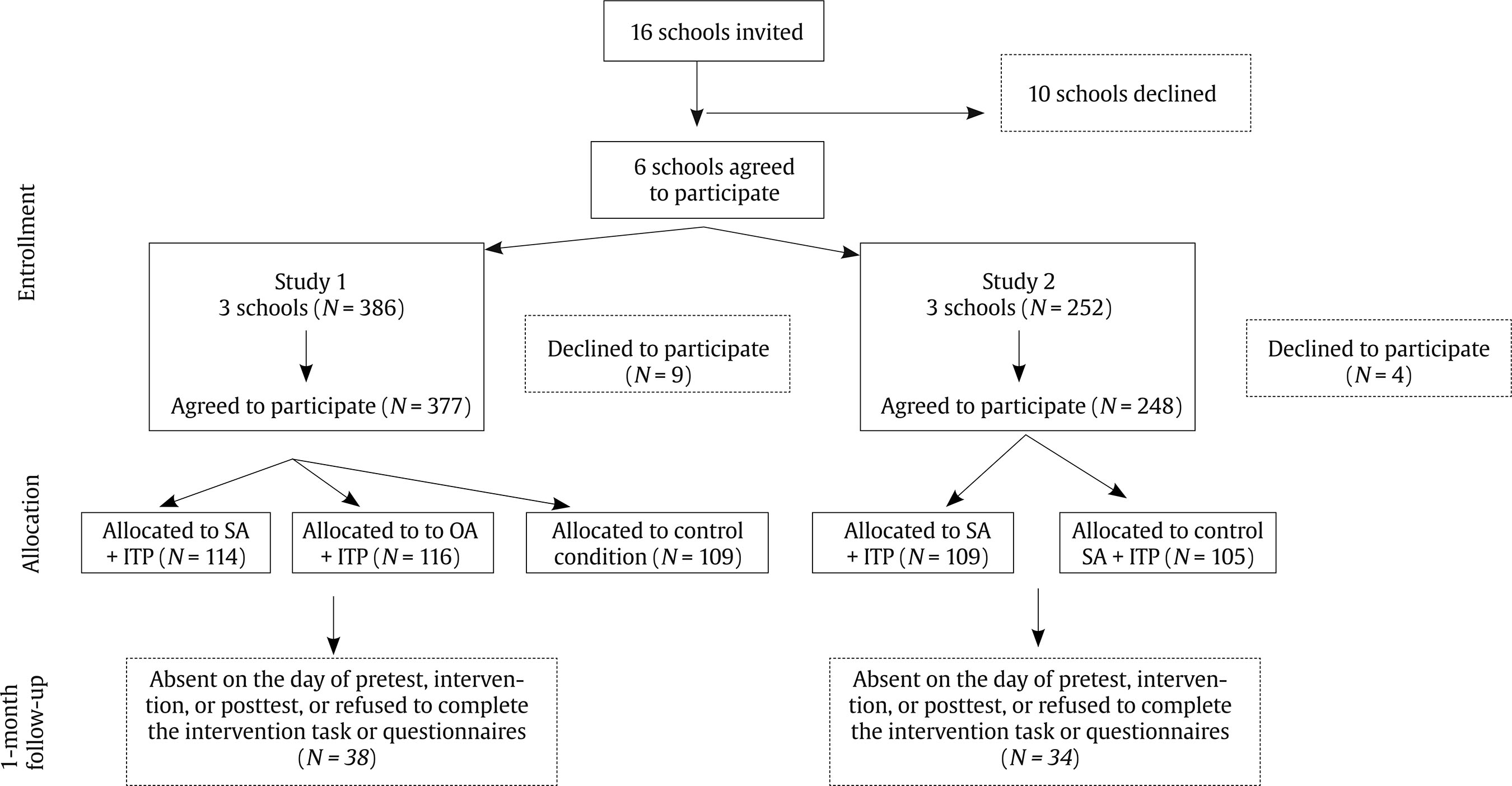 Note. SA = self-affirmation; OA = other-affirmation; ITP = Incremental Theory of Personality. The participants completed the pretest and posttest measures through Qualtrics© on the school computers. The time required to complete the questionnaires ranged between 20 and 30 min. Assessment measures for the study were administered one week before the intervention (pretest; T1) and one month after (posttest; T2). Pretest measurements were taken in October 2019. Figure 1 displays the rates of participants at each step. The main reason for attrition was sickness. Furthermore, many questionnaires could not be crossed due to errors in the codes. No statistically significant differences were observed in terms of condition, sex, age, or the pretest measures of cyberbullying perpetration and sexualized interaction with adults among adolescents who completed both measures (pretest and posttest; n = 339, 94.2%) and those who failed to complete the posttest measures (n = 21, 5.8%). Research assistants administered the interventions and assessment measures during regular class hours. Participation was voluntary, and parents were informed and given the option to decide whether or not their children could participate. Only 2.33% of the parents refused participation. The project was approved by the Ethics Committee of the University of Deusto. Measures. The Cyberbullying Questionnaire (CBQ; Calvete et al., 2010; Gámez-Guadix et al., 2014) was used to assess the perpetration of cyberbullying (9 items; e.g., “Posting or sending humiliating images of classmates” and “Broadcasting online other people’s secrets, embarrassing information, or images”). The answer format of the items ranged from 0 (never) to 4 (almost every week). In the pretest and posttest, the participants indicated the frequency of each behavior in the previous six months and one month after the intervention, respectively. Cronbach’s alpha coefficients were .81 and .71 in the pretest and posttest, respectively. The participants also reported the frequency of cyberbullying victimization one month after the intervention in the posttest using the victimization scale of the CBQ, which includes 9 parallel items (e.g., “Writing embarrassing jokes, rumors, gossip, or comments about me on the Internet” and “Receiving threatening or insulting messages”). Cronbach’s alpha coefficient was .77. The Online Sexual Solicitation and Interaction of Minors with Adults Questionnaire (Gámez-Guadix, De Santisteban et al., 2018) was employed. It contains ten items that assess sexual interactions that are part of the initiation, process, and/or result of online grooming. In the pretest and posttest, the participants indicated the frequency of each behavior in the previous six months and one month after the intervention, respectively. The questionnaire consists of two factors. The Sexual Solicitation factor refers to sexual requests by an adult to an adolescent, which places the adolescent as a receptor of the adult behaviors (e.g., “An adult asked to me online to have cybersex via a webcam”). The Sexualized Interaction factor includes items that describe behaviors of adolescents related to intimate or sexual interactions with adults (e.g., “We have met offline to have sexual contact” and “I talked about sexual things with an adult through the Internet”). Items are rated on a four-point response scale ranging from 0 (never) to 3 (6 or more). Cronbach’s alpha coefficient for Sexual Solicitation was .88 for the pretest and posttest. For Sexualized Interactions, these values reached .86 and .78 in the pretest and posttest, respectively. Table 1 Correlations, Means, and Standard Deviations of Variables   †p < .10, *p < .05, **p < .01, ***p < .001 Interventions. A triple-blind randomized controlled trial with three parallel groups was conducted. Three interventions were used, namely, (a) SA + ITP, (b) OA + ITP, and (c) control. The SA + ITP intervention included two components, an SA activity and an ITP intervention. The SA component included a list of values from which students chose two or three they deemed most important. They were then instructed to explain the importance of the selected values. The ITP component resembled the intervention developed by Yeager et al. (2013) and was adapted to the Internet context. It consisted of three parts as follows. (1) Participants read scientific studies indicating that people can change. Furthermore, they read other studies that provided evidence of how thoughts and feelings control behaviors through brain pathways, and that these brain pathways can change under certain circumstances. Next, they were instructed to write a brief paragraph explaining why the evidence shows that people can truly change. (2) Participants read testimonies that support the conclusions that people also have the potential to change in the context of the Internet. To lend credibility to the ITP, students were told that other students who previously completed the intervention wrote such narratives. One of the narratives described the experience of a teenager who perpetrated cyberbullying against another teenager and how meeting the victim changed the behavior. The story featured an important component of empathy with victims. The two other narratives involved sexual solicitation and sexting experiences. All stories included the message that certain behaviors on the Internet are negative and risky, and that young people can change the way they behave on the Internet. (3) Lastly, participants were asked to complete a self-persuasive writing exercise to share with future students. They were instructed to describe a time when they experienced problems on the Internet because of an action with negative consequences for them or others. In addition, students were asked to imagine that another student was experiencing the same event and to write a few paragraphs with examples, explaining how people can behave appropriately on social networks. The OA + ITP intervention included the above-mentioned ITP component and an SA control intervention (i.e., OA), in which the participants were asked to select two or three values they considered least important. Next, they had to write why such values, although least important for them, could be important for other people. Figure 2a-2b The Association between Victimization and Sexualized Interaction and Cyberbullying Moderated by the Interventions.  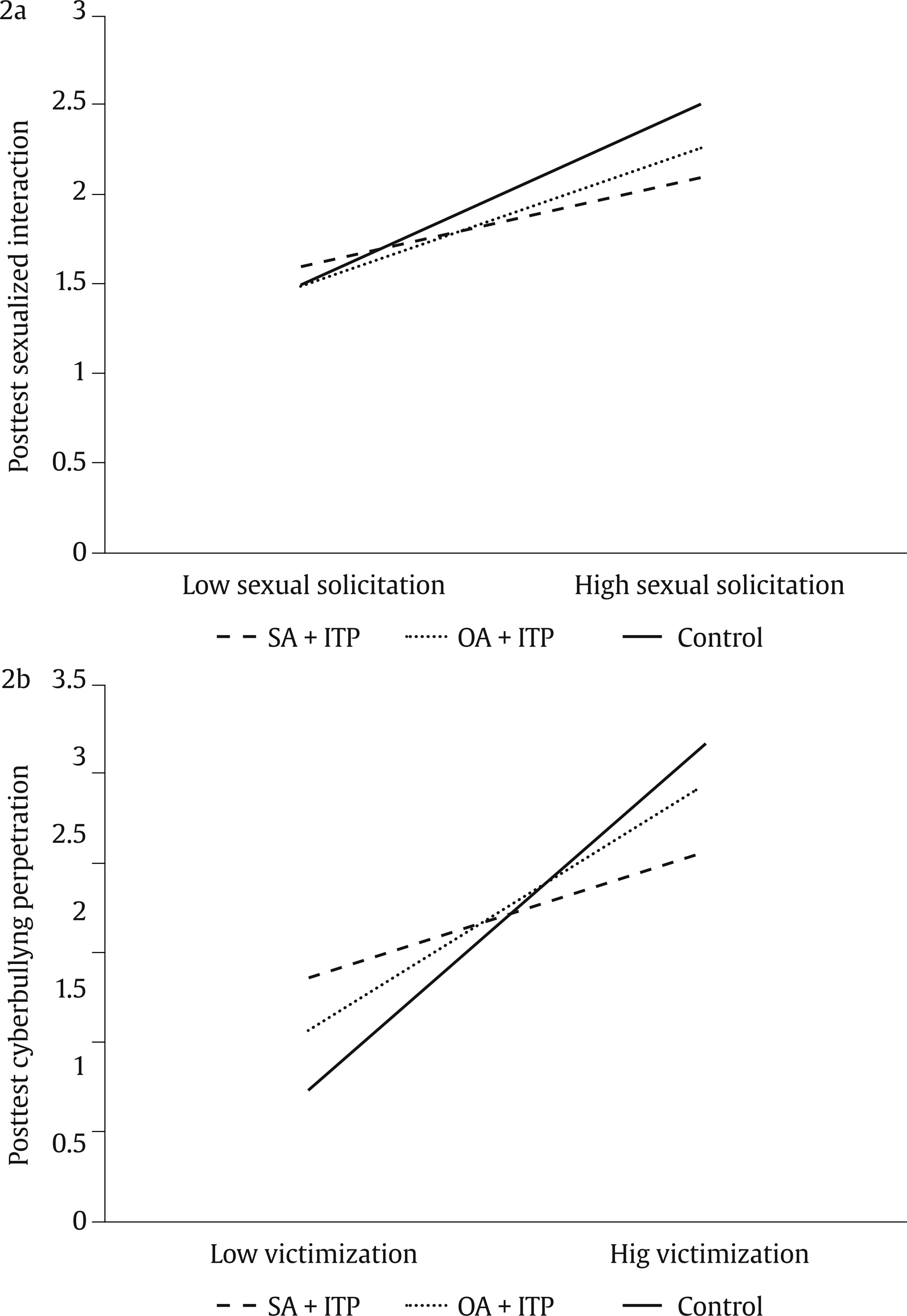 Note. SA = self-affirmation; OA = other-affirmation; ITP = Incremental Theory of Personality. The control intervention required completing a series of problem-solving tasks, such as arithmetic exercises, number sequences, and riddles. All conditions were completed in approximately 50-60 min. Statistical approach. A series of hierarchical multiple regression analyses with SPSS-26 were performed to test the hypothesis that the intervention moderated the predictive association between victimization and perpetration of cyberbullying and sexualized interaction in the participants. Given the three interventions, the intervention was modeled with two dummy variables that specified the effects of each experimental condition (i.e., SA + ITP and OA + ITP) by contrasting their effects with those of the control condition, which acted as the reference group. In the first step of the analyses, the pretest level of behavior was regressed on the posttest level of behavior. In the second step, each of the two experimental conditions and the level of victimization for the previous month were included as predictor variables. Finally, in the third step, interaction terms between intervention conditions and victimization were included. Following standard procedures, the study transformed victimization and pretest levels of behaviors into z-scores to maximize interpretability. Preliminary analyses also examined the role of sex and age as predictors of outcomes and potential moderators of the intervention. Data is available at https://osf.io/hkys9/. Results Descriptive statistics and pretest comparisons. Table 1 displays mean, standard deviations, and correlations of variables. Results showed that all correlation coefficients were significant, except for the correlation between T1 sexualized interactions and T2 cyberbullying perpetration, which was marginally significant. In addition, comparisons between conditions yielded no significant differences between the experimental (SA + ITP, OA + ITP) and control groups in terms of sex, age, or the pretest measures of cyberbullying perpetration and sexualized interaction with adults. Direct effects of intervention on risk behaviors. Preliminary analyses indicated that sex and age did not predict change in cyberbullying perpetration (p = .73 and .97, respectively) and sexualized interaction (p = .67 and .63, respectively) and did not moderate the effect of the intervention (p-values between .45 and .79 for cyberbullying perpetration and between .10 and .66 for sexualized interaction).Therefore, these variables were eliminated in subsequent analyses. Intervention modality did not predict a reduction in risk behaviors in the posttest compared with the control group. Coefficients for SA + ITP were β = .05, t = 0.89, p = .37 for cyberbullying and β = -.07, t = -1.25, p = .21 for sexualized interaction with adults. The coefficients for OA + ITP were β = .03, t = 0.61, p = .54 for cyberbullying and β = -.05, t = -0.87, p = .39 for sexualized interaction with adults. Effects of interventions on reciprocity between victimization and risk behaviors. Table 2 displays the results for hierarchical regression analyses. For sexual interaction, in the first step, pretest level of sexualized interaction significantly predicted posttest level of sexualized interaction. In the second step, sexual solicitation significantly predicted high levels of sexualized interaction, whereas the SA + ITP condition displayed a marginally significant negative effect on sexualized interaction. Finally, the interaction term between SA + ITP and sexual solicitation was statistically significant. Posthoc analyses comparing the effects for SA + ITP and OA + ITP revealed no differences for the direct effect (t = -0.69, p = .49) or the moderating effect of reciprocity (t = -1.71, p = .17). Figure 1 depicts the association between sexual solicitation and sexualized interaction under the three conditions. The figure represents levels of socialized interaction for adolescents with low (mean – 1 SD) versus high (mean + 1 SD) scores for sexual solicitation under the three conditions. As observed, association between sexual solicitation and sexualized interaction is lower in the SA + ITP condition (β = .26, t = 4.71, p < .001) than in the control condition (β = .50, t = 7.07, p < .001). The model for cyberbullying perpetration indicated that none of the experimental conditions predicted lower levels of cyberbullying perpetration in the posttest. However, both interventions reduced the reciprocity between cyberbullying victimization and cyberbullying perpetration. Figure 2 displays the form of the SA + ITP x Victimization and OA + ITP × Victimization interactions. The association between cyberbullying victimization and posttest perpetration was higher in the control condition (β = 1.13, t = -9.25, p < .001) than in the SA + ITP (β = .41, t = 4.31, p < .001) and OA + ITP (β = .79, t = -7.53, p < .001) conditions. Posthoc analyses comparing the effects for SA + ITP and OA + ITP yielded no differences for the direct effect (β = -.06, t = -0.39, p = .69) on cyberbullying perpetration. However, the moderating effect on reciprocity was statistically higher for SA + ITP than for OA + ITP (β = -.60, t = -4.05, p < .001). Table 2 Hierarchical Regression Analyses for the Moderating Effects Of SA + ITP and OA + ITP on Reciprocity between Victimization and Risk Behaviors  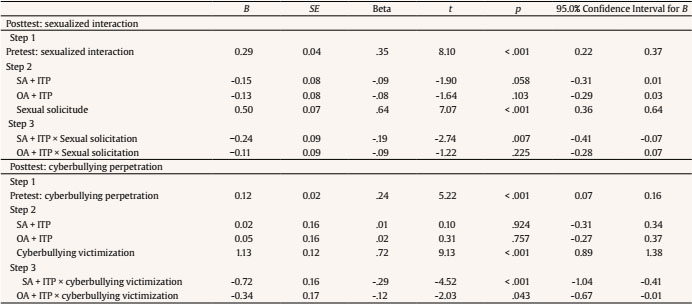 Note. SA = self-affirmation; OA = other-affirmation; ITP = incremental theory of personality. Discussion The results of Study 1 show that the two interventions with ITP reduced the reciprocity between victimization and cyberbullying perpetration. The SA component was relevant because the combination of ITP and SA was more effective than the combination of ITP and OA in reducing reciprocity. Regarding grooming behaviors, the combination of ITP and SA, but not ITP and OA, reduced the reciprocity between sexual solicitation and sexualized interaction. Together, results provide support for the SA + ITP intervention. However, neither intervention had a direct effect on risk behaviors. This result should be interpreted in light of the methodology used. As a pretest measure, adolescents provided answers about the frequency of behaviors performed during the last six months, which prevented a direct comparison between the pretest and posttest measures with the latter referring to the month after the intervention. Study 2 addresses this limitation. Study 2 focused on the SA + ITP intervention, which showed better results in Study 1. Moreover, Study 2 aimed to overcome the limitation of Study 1, including the pretest measures referring to risk behaviors performed in the month before the intervention. Method Participants and procedure. As displayed in Figure 1, out of the 16 schools invited to participate, the headmasters of three private schools agreed to participate in Study 2. As in Study 1, schools reported that students had not received any previous intervention program on Internet risks. The final sample comprised 214 adolescents (50.30% were male, mean age = 14.06 years, SD = 0.96) who completed the interventions. They were studying grades 7, 8, and 9 (37.3%, 41%, and 21.7%, respectively). Similar to Study 1, the participants completed the questionnaires in their school computers via Qualtrics©, with the exception of participants from one of the schools (n = 52), who were confined at home due to COVID-19 and who completed the posttest questionnaires at home. Random assignment, blinding procedure, and intervention administration were similar to those in Study 1, although only the intervention found to be most effective in Study 1 (i.e., SA + ITP) was tested for Study 2. The pretest measurements were taken in January 2020 (one week before the intervention), whereas the posttest measures were taken one month after the intervention. Figure 1 displays the rates of participants at each step. A total of 109 participants were allocated to the experimental condition and 105 to the control condition. Study 1 indicated that attrition was mainly due to sickness and errors in the codes, which prevented matching some pretest and posttest measures. For Study 2, 1.58% of parents refused participation. Attrition analyses revealed no significant differences between adolescents who completed both measures (pretest and posttest; n = 195, 91.10%) and those who failed to complete any of the measures (n = 19, 8.90%) in terms of condition or sex, although non-completers were significantly older (Mage = 15.03) than completers (Mage = 14.56), t(212) = 2.08, p < .05. Table 3 Hierarchical Regression Analyses for the Moderating Effects Of SA + ITP and OA + ITP on Reciprocity between Victimization and Risk Behaviors   *p < .05, **p < .01, ***p < .001. Measures. Participants completed the same questionnaires used for Study 1 at pretest and posttest. All measures were completed with reference to the previous month. Alpha coefficients were .70 and .87 for cyberbullying perpetration, .73 and .77 for cyberbullying victimization, .85 and .88 for sexual solicitation, and .81 and .84 for sexualized interaction at pretest and posttest, respectively. Interventions. As previously explained, the SA + ITP intervention was compared with the control condition. The two interventions followed the same structure as outlined in Study 1. Statistical Analyses. Hierarchical linear modeling was used with robust standard errors and full information maximum likelihood, a method recommended to manage missing values when they are not distributed randomly, with HLM8. Separate models for cyberbullying perpetration and sexualized interaction were estimated. At level 1, regression equations modeled the variation in the repeated measures as a function of time (0 = pretest, 1 = posttest). At level 2, equations represented individual differences at level 1 parameters (i.e., intercepts and slopes) as a function of the condition (0 = control, 1 = SA + ITP). Sex and age were controlled in the analyses. Random effects for intercept and time were included at level 2 for all models to consider variability between individuals at the initial levels and changes over time. Nonsignificant random effects were removed from the final models. To examine whether the SA + ITP intervention moderated the reciprocity between victimization and risky behaviors, the level of victimization (i.e., cyberbullying victimization and sexual solicitation) was included in the above-mentioned models as a level 1 predictor of outcomes. In addition, the intervention was included as a predictor of the slope between victimization and perpetration at level 2. Results Descriptive statistics and pretest comparisons. Table 3 provides means, standard deviations, and correlations of variables. Correlations between study variables were significant, except for correlations between T1 sexualized interaction solicitation and T1 cyberbullying perpetration and between T2 cyberbullying perpetration and T2 cyberbullying victimization. In addition, comparisons in the pretest measures between experimental and control conditions indicated no significant differences between conditions in terms of sex, age, or sexualized interaction with adults. However, mean scores for cyberbullying perpetration at pretest were significantly higher for adolescents in the experimental condition (M = 1.43) than the control condition (M = 0.88), t(211) = 2.00, p <.05. Table 4 Results of Multilevel Analyses for Sexualized Interaction and Cyberbullying Perpetration  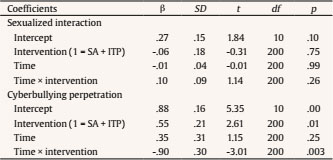 Note. SA = self-affirmation; ITP = Incremental Theory of Personality Simple effects of intervention. Sex and age were not significantly associated with cyberbullying perpetration (p = .52 and .16, respectively) or sexualized interaction (p = .23 and .14, respectively) and did not moderate the effect of the intervention (p = .81 and .78, respectively, for cyberbullying perpetration, and p = .47 and .25, respectively, for sexualized interaction). Therefore, they were dropped from the models. The final models are displayed in Table 4. There was no statistically significant effect of the intervention on sexualized interaction. However, the time x intervention interaction was statistically significant for cyberbullying. Figure 3 displays the different trajectories between the pretest and posttest for adolescents in the SA + ITP (β = -.55, t = -3.08, p = .002) versus control (β = .35, t = -1.14, p = .25) groups. Estimated marginal means of cyberbullying increased in the control group from 0.88 (SE = 0.14) to 1.43 (SE = 0.13) and decreased in the SA + ITP group from 1.17 (SE = 0.14) to 0.91 (SE = 0.14). Table 5 displays the random effects of all models. Figure 3 Change in Cyberbullying Perpetration.  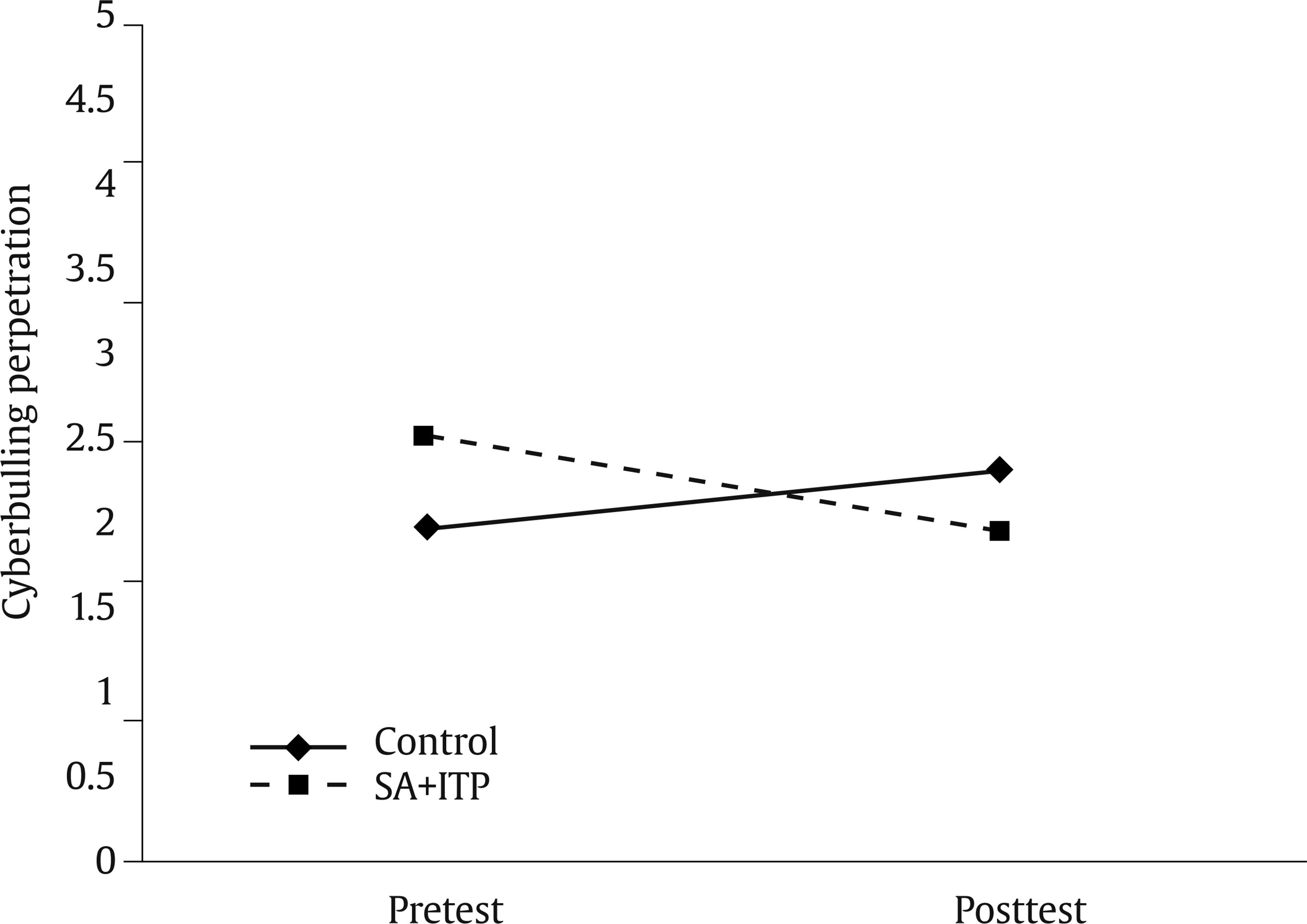 Note. SA = self-affirmation; ITP = Incremental Theory of Personality Effects of intervention on reciprocity between victimization and risky behaviors. Table 6 displays the fixed effects of the hierarchical multilevel models. The SA + ITP intervention significantly reduced the predictive association between sexual solicitation and sexualized interaction. Figure 4 displays the form of this effect. In the control condition, the slope of the predictive association between sexual solicitation and sexualized interaction tends to be positive (β = .09, t = 1.92, p = .056), whereas the slope tends to be negative in the SA + ITP condition (β = -.24, t = -1.73, p = .08). An examination of the estimated marginal means indicated that, in the SA + ITP condition, sexualized interaction increased from pretest to posttest (mean = 0.20, SE = 0.12 at pretest; mean = 0.30, SE = 0.15 at posttest) but this increase was associated with an increase in sexual solicitation (mean = 0.35, SE = 0.15 at pretest; mean = 0.50, SE = 0.17 at posttest). Instead, in the control group sexualized interaction remained equal from pretest to posttest (mean = 0.29, SE = 0.13 both at pretest and posttest) although sexual solicitation decreased (mean = 0.56, SE = 0.16 at pretest; mean = 0.51, SE = 0.17 at posttest). Table 6 Results of Mixed Linear Models Predicting Intervention Effects on Reciprocity between Victimization and Perpetration (Fixed Effects)  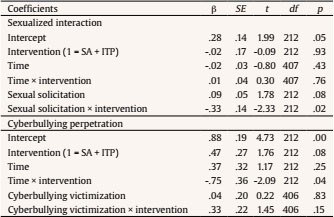 Note. SA = self-affirmation; ITP = Incremental Theory of Personality. Figure 4 Effects on Reciprocity between Sexual Solicitation and Sexualized Interaction with Adults.  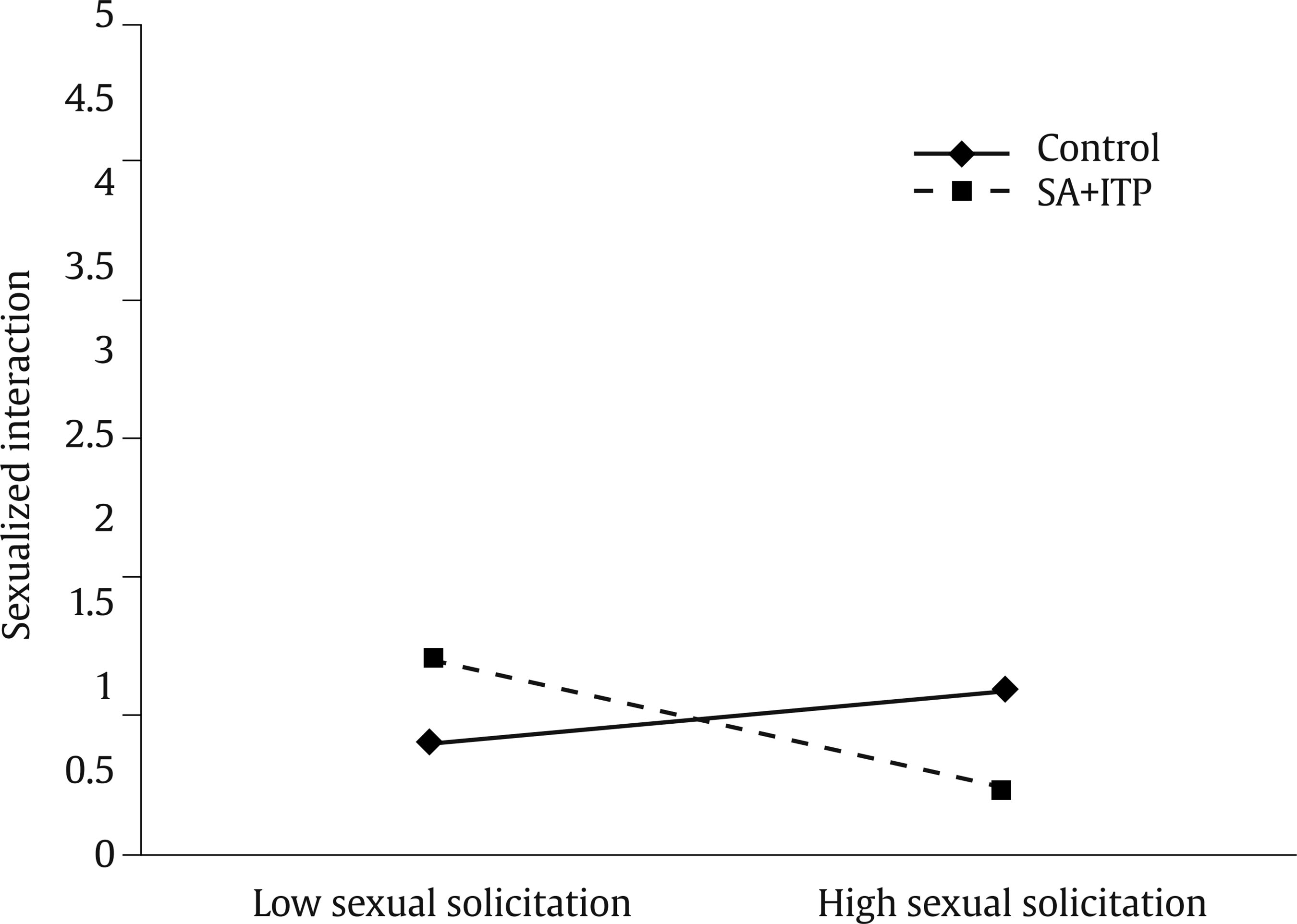 Note. SA = self-affirmation; ITP = Incremental Theory of Personality Discussion The results of Study 2 imply that, similar to Study 1, the SA + ITP intervention reduced the reciprocity between sexual solicitation and sexualized interaction. In other words, adolescents who received the intervention showed less sexualized interaction behaviors when experiencing sexual solicitations from adults on the Internet compared with adolescents in the control condition. However, Study 2 failed to obtain the same effect for reciprocity between cyberbullying victimization and perpetration. In contrast, the SA + ITP intervention showed a direct main effect in reducing cyberbullying perpetration behavior. The study investigated the effects of a brief intervention for adolescents regarding two relevant online problems, namely, cyberbullying and grooming. The intervention is framed in the context of the so-called wise interventions and combines an SA exercise (Cohen & Sherman, 2014; Good & Abraham, 2011) with an ITP intervention (Miu & Yeager, 2015; Yeager et al., 2013). In terms of grooming, both Studies 1 and 2 showed that the combination of SA and ITP reduced the reciprocity between sexual requests and risky behaviors of sexualized interaction with adults. This finding is important because teenagers spend a lot of time surfing the Internet. Thus, avoiding the experience of receiving requests for sexual material by adults is very difficult, to a certain extent. The intervention developed in this project seems to protect adolescents from these situations by reducing the probability of their responding by sharing sexual materials of themselves with adults. The correlation between sexual solicitation and sexualized interaction in Study 1 reached .50 in the pretest and was reduced to .20 in the posttest. Furthermore, Study 1 indicated that the combination of ITP and SA reduced the aforementioned reciprocity, whereas no differences were noted between the OA + ITP and control conditions. The previous study conducted by Gámez-Guadix (2018), which assessed the impact of an online grooming prevention program, found a significant increase of appropriate knowledge and attitudes about this risky behavior in the experimental group, but behavioral changes were not reported. Our findings imply a relevant step in the online grooming prevention literature, given the lack of efficacy evaluations of online grooming preventive strategies aimed at child and adolescent potential victims (Forni et al., 2020). Regarding the perpetration of cyberbullying, results were relatively different between Studies 1 and 2. Although Study 1 showed that both interventions (SA + ITP to a greater extent than OA + ITP) reduced reciprocity between victimization and perpetration, Study 2 failed to find significant results for reciprocity. In contrast, Study 2 obtained a main effect of the intervention in reducing cyberbullying perpetration. Previous studies that have examined the efficacy of cyberbullying preventive interventions have found evidence for a reduction in cyberbullying perpetration and victimization (Gaffney et al., 2019), which is consistent with our results. However, direct comparison of the results from different studies is difficult due to differences in the study designs, measures, and statistical analysis plan. Preventive interventions also differ in length and theoretical background and, although no direct comparisons are possible, our 1-hour wise intervention combining SA with ITP has shown some promise in the prevention of cyberbullying with results that resemble those of longer interventions. Interestingly, Ng et al. (2020) concluded that program duration did not moderate anti-bullying program effectiveness. Moreover, the differences between Studies 1 and 2 may be due to the different methodologies used. The method used in Study 1 for the pretest measurement referred to a longer time interval than that used in Study 2. For this reason, different strategies for statistical analyses were used. Calvete, Orue, et al. (2019) found that another ITP intervention reduced the frequency of cyberbullying perpetration and reciprocity between victimization and perpetration. However, the authors included measures regarding behaviors in the previous six months in pretest and follow-up. Therefore, the interval between measures probably influenced findings. An innovative aspect of the present studies is the examination of the effects of the intervention on the reciprocity between victimization and perpetration, which has been examined only in one previous study (Calvete, Orue et al., 2019). We can only speculate about the mechanisms through which the intervention contributes to this effect. The ITP component of the intervention included stories in which adolescents entered into escalations of violence which they later regretted. The writers of these stories changed their way of thinking and behaving. The stories also included elements of empathy towards the victims and the idea that young people who are aggressive against others often act this way because they themselves have major problems in their lives. On the other hand, the SA component of the intervention has been proposed to contribute to activating positive elements of the self-concept (Cohen & Sherman, 2014). This mechanism could be especially beneficial in victims and make them less inclined to initiate vengeful courses of action. The results obtained should be considered preliminary due to the limitations of Studies 1 and 2. The main limitation is that neither of the studies included a follow-up beyond one month after the intervention. Such a follow-up is necessary to determine the maintenance of the effects of the intervention. Furthermore, given their recursive nature, wise interventions are expected to exert long-term effects by interacting with individuals’ experiences after the intervention. Thus, Kenthirarajah and Walton (2015) and Walton (2014) proposed that wise interventions have the potential of setting in motion recursive cycles that promote behavioral changes over time through the snowball effect. The second limitation refers to the temporal range of pretest measurements. As previously mentioned, Study 1 used a longer time range because the previous one month was considered inadequate for capturing the presence of the risk behaviors evaluated. However, the use of a longer time range rendered the comparison of pretest and posttest measurements difficult. Study 2 solved the problem of comparison by referring to pretest and posttest measures of the previous month. However, this aspect limited the ability to identify problem behaviors that may have occurred several months before the intervention. A third limitation is the exclusive use of self-reports. In the case of grooming, self-report seems the most appropriate form of measurement, whereas in the case of cyberbullying, reports from other peers might have been interesting. Finally, the study did not include measures of variables that can mediate the effects of the intervention, which included stories that described the evidence that people can change in general and the way they behave on the Internet in particular. Future studies should include measures of empathy toward victims, perception of risks for certain online behaviors, and incremental theory of personality beliefs. Including the measures of these aspects is important to determine their potential mediating roles in the effects of the intervention. For instance, previous research has demonstrated that other ITP interventions increase ITP beliefs (e.g., Calvete, Fernández-González, et al., 2019; Schleider & Weisz, 2016), and it would be adequate to test whether the ITP intervention developed in the current study had a similar effect. In addition, it would be adequate to assess whether the participants have the necessary reading and writing skills to understand the intervention. Despite such limitations, Studies 1 and 2 have strengths. Both used experimental designs, and allocation to the conditions was individualized. The fact that the adolescents in each classroom were distributed among the different experimental conditions may have caused a certain “contagion” in the effects of the interventions. However, had this effect occurred, it would have helped to reduce differences between groups and would have worked against our hypothesis. Moreover, the SA + ITP intervention is applicable in approximately 1 h but it has shown significant effects one month later on two problematic behaviors in adolescents. Although the effects are small, long-term and very expensive interventions typically show very small effects on changes in adolescent behavior in retrospect (for a review, see Yeager et al., 2015). Furthermore, in the case of online grooming, a significant need is clear for further studies evaluating the efficacy of interventions (Forni et al., 2020). Future research should test the efficacy of the SA + ITP intervention in different samples and include longer follow-up measures. Larger samples should be used to examine for which participants the intervention is most beneficial. Previous research found that ITP interventions were more beneficial among younger adolescents (Calvete, Fernández-González et al., 2019). However, in the current study, there were no differences as a function of age, probably because the samples were relatively small and homogenous in age. In summary, the results of present studies are promising and provide preliminary evidence of the potential of a wise intervention in reducing two online risk behaviors in adolescents. Future studies should examine the efficacy of the intervention over time as well as its mediating mechanisms. Conflict of Interest The authors of this article declare no conflict of interest Author Contributions E.C. conceived of the study, participated in its design, performed the analyses, and prepared the initial draft of introduction and discussion; A.E., N.C., and L.F-G participated in the review of the literature andwrote part of the method section. A.L., J.G-C., and M.B participated in the review of the literature and design of the interventions; I.O. participated in the design and completed part of the introduction and discussion. All authors read and approved the final manuscript. Cite this article as: Calvete, E., Cortazar, N., Fernández-González, L., Echezarraga, A., Beranuy, M., León, A., González-Cabrera, J., & Orue, I. (2020). Effects of a brief preventive intervention in cyberbullying and grooming in adolescents. Psychosocial Intervention, 30(2), 75-84. https://doi.org/10.5093/pi2020a22 Funding: This research was supported by a grant from the Fundación BBVA (Banco Bilbao Vizcaya Argentaria) (Ref.PR[18]_SOC_0096) and from the Basque Country (Ref. IT982-16). |
Cite this article as: Calvete, E., Cortazar, N., Fernández-González, L., Echezarraga, A., Beranuy, M., León, A., González-Cabrera, J., and Orue, I. (2021). Effects of a Brief Preventive Intervention in Cyberbullying and Grooming in Adolescents. Psychosocial Intervention, 30(2), 75 - 84. https://doi.org/10.5093/pi2020a22
esther.calvete@deusto.es Correspondence: esther.calvete@deusto.es (E. Calvete).Copyright © 2025. Colegio Oficial de la Psicología de Madrid


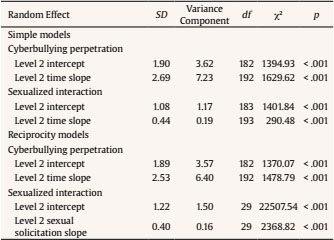






 e-PUB
e-PUB CrossRef
CrossRef JATS
JATS






